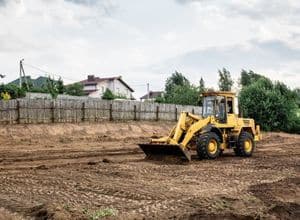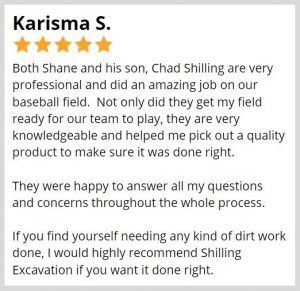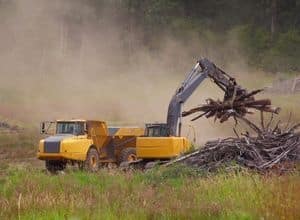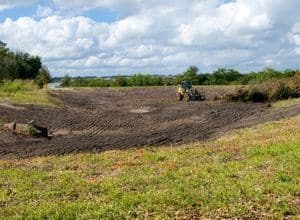The removal of brush, trees, and stumps is known as land clearing and brush removal. You want an open area to work with while clearing residential property, but you also want to keep some vegetation, bushes, and trees intact. Residential clearance is tailored to the specific needs of each client.
Few trees are left after commercial land clearing and brush removal, generally just along property borders. Trees are felled with their stumps intact, the wood is sold, and the trash is scraped and heaped. Following debris removal, the property is bladed to a smooth surface.
Overgrown trees and dead shrubs are not just ugly; they may also reduce the value of your home and offer serious health and safety risks.
Property owners may have their land looking like new by hiring a land clearing and brush removal service. Continue reading to discover more about land clearing and brush removal services, as well as how they may help you.
When Do You Need Land Clearing And Brush Removal Services?

Land clearing and brush removal services provide several advantages. Hiring land clearing professionals may be required for the health and operation of your property, depending on your objectives and land area.
But when do you need land clearing and brush removal services? Land clearance may restore functionality to an area of land that has become unusable owing to overgrown rubbish.
Alternatively, land may occasionally offer substantial health dangers due to its susceptibility to fire or the presence of disease vectors. When this occurs, removing the ground of dead or decaying plants makes the region more secure.
Common Land Clearing And Brush Removal Questions
Many questions might arise while clearing land. For instance, how do businesses clear land? How can you determine whether your company requires land clearing and brush removal services? And, maybe most crucially, how much will it cost? Continue reading to uncover the answers to these frequently asked land-clearing questions.
What Equipment Is Used For Land Clearing And Brush Removal?
Contractors will often utilize various tools and equipment to clear your property. The specific equipment they will employ is determined by the amount of vegetation, the size of your land, and so on.
Some of the equipment used by land clearing and brush removal businesses include:
- Tractors
- Bulldozers
- Chains for anchoring
- Skid steers
- Backhoes\sTrucks
Does Land Clearing And Brush Removal Increase The Value Of A Home?

Land clearing and brush removal do boost property value. Not only will your property be safer from fire threats, bugs, mildew, and viruses that decaying trees may house on, but it will also look a lot prettier. As a consequence, the curb appeal of your property will significantly improve.
How Much Are Land Clearing And Brush Removal Services?
When it comes to evaluating the cost of land clearing services, there is no one-size-fits-all solution. Instead, the cost heavily depends on the size of your property and the exact brush clearing services you need.
How Can Land Clearing And Brush Removal Services Help Your Company?
There are several advantages to clearing land. When you remove dead or decaying trees, you dramatically lessen the likelihood of pests and mold spreading, which are often found within dying trees and plants.
You also enable preferred flora to flourish since there is less competition for nutrients and sunlight. Clearing land also aids in soil regeneration, bringing more nutrients to the soil for healthier, more vigorous plant growth.
Finally, the chance of a fire spreading to your property is substantially decreased in the absence of dry, dead vegetation.
The Importance Of Hiring Professional Land Clearing And Brush Removal Services
Hiring professionals that provide a range of land clearing and brush removal services is the most effective approach to maintaining your property in excellent condition.
They may help you remove undesirable vegetation efficiently, prepare it for personal use, and raise the value of your house if you want to sell it.
Some people, however, think that professional land clearance is unneeded. Can’t tree stumps and vegetation be cleared by hand, after all? That is not always the case.
Continue reading to find out why you must look for land clearing and brush removal near me.
Security
Land clearing and brush removal is a dangerous task that may endanger anybody who is unfamiliar with the safety requirements. Qualified specialists have specific tools and equipment for the work, such as bulldozers, graders, soil compactors, and excavators.
Furthermore, by hiring land clearing and brush removal services, you improve the safety of your yard by eliminating dangerous stumps.

Stump removal and other difficulties demand properly educated and experienced professionals that complete the task without causing damage to your property or injury.
Hiring a competent land clearing and brush removal business also eliminates the possibility of injuring a bystander, which is particularly important when there is a high wind.
Improvement Of Your Property’s Appearance
If your backyard is left ignored, it may rapidly become overrun with weeds, rubbish, weed bushes, and weeds. Removing any unnecessary things will, in the end, improve your health and the aesthetic of your home.
If you want to sell your home, you must have any undesired objects removed. Then you might think about adding fresh flowers and beautiful plants. This will raise the value of your home and attract prospective buyers.
Benefits Soil Health
When weeds take over your land, it may be difficult for desired plant-like turf grass to flourish. Weeds grow quickly and are likely to choke out the plants you want to have on your land.
You may level the ground and increase the soil’s health by employing expert cleaning services.
Get Rid Of Pests
Pests are more likely to hide if your land is overgrown with bushes, weeds, and rubbish, among other things. Unattended plants and debris may also serve as breeding grounds for fleas, mosquitoes, and ticks.
These pests may be dangerous to your health and the health of your pets. You may exterminate bugs and prevent them from returning by employing cleaning services.
Reduces Fire Hazards
If dried twigs, dead plant materials, and overgrown plants are strewn around, your property is in danger of catching fire. Only by eliminating these components can the danger of fire be eliminated.

Hiring land clearing and brush removal specialists will eliminate any combustible debris, lowering the likelihood of a fire spreading to surrounding land or buildings.
Even if our land is not in use, vegetation treatment and debris removal may lessen the danger of a fire.
Work Is Done Effectively And Quickly
Cleaning contractors can do the work in ways that will improve the appearance of your house due to their knowledge and competence. Because they are knowledgeable about the work, they will do it efficiently and without causing harm to your property.
Hiring pros will also guarantee that your property is ready for a new building on time.
Clean Environment
A land clearing and brush removal company must follow government regulations for wildlife conservation. Professional land clearing and brush removal clearing services are also likely to participate in environmentally beneficial activities such as recycling, stumps, and timber. They may turn them into mulch that feeds the soil.
The authorities likewise regulate land clearing agencies. As a result, they must get permission before beginning land removal operations.
Minimize Damages
Some types of clearance, such as root removal, might harm subsurface wires and pipelines. As a result, such cleaning efforts must be carried out with caution.
Professional cleaning services understand how to execute subsurface excavation without disrupting underground wires and pipelines. They may also devise new methods of removing stumps without having to dig out the roots, lowering the danger of injury.
Manage Various Land Clearing Requirements
Land clearing and brush removal personnel with experience are always ready to tackle any clearing problem. They have the necessary equipment for the task, whether it’s clearing shrubs, cutting stumps, or disposing of rubbish.
As a result, they may obtain the desired outcome and prepare your house for the next project.
Encourages Plant Growth
Plant health and growth may benefit from land clearing and brush removal. By removing overgrown vegetation, your plants will get nutrients that were previously inaccessible due to competition. Clearing ground also allows flora to have easier access to the nutrients it needs for growth.




